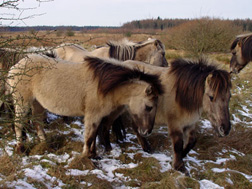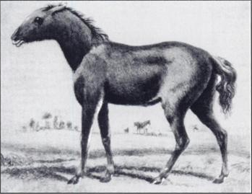 Front page news last week – some of us are, after all, genetically linked to that lowbrow brute the Neanderthal Man. Let’s hope geneticists don’t get carried away with this train of eugenics. It happened in Nazi Germany with the Tarpan, a wild European forest horse.
Front page news last week – some of us are, after all, genetically linked to that lowbrow brute the Neanderthal Man. Let’s hope geneticists don’t get carried away with this train of eugenics. It happened in Nazi Germany with the Tarpan, a wild European forest horse.
The 1841 engraving, below right, of a 5-month old colt is the only image of a Tarpan known to have been drawn from life. Although they had long since been hunted to extinction in Great Britain, Tarpans survived in Central Europe until the late 1800s. The last of the breed died in captivity in 1910, but there were still domestic Konik ponies in Poland with many of the same physical characteristics – dun-colored coats, zebra-like stripes on their legs, barrel chest with lack of withers, thick dark manes and tails, and dorsal stripes.
 Since the Tarpan had played a role in German folklore, senior Nazi officials, including Herman Goering, supported an effort to selectively “back-breed” to the Tarpan. Whole herds were stolen following the invasion of Poland and sent to Germany for the experiments, only to be slaughtered and eaten by starving German citizens in the final days of the war.
Since the Tarpan had played a role in German folklore, senior Nazi officials, including Herman Goering, supported an effort to selectively “back-breed” to the Tarpan. Whole herds were stolen following the invasion of Poland and sent to Germany for the experiments, only to be slaughtered and eaten by starving German citizens in the final days of the war.
Those that escaped capture by the Germans in Poland were allowed to range the national parks and when the Iron Curtain fell, conservationists were able to transport them to other countries.
A project in the Kentish Wetlands of Great Britain has the aim of releasing large herbivores such as Konik horses, whose original habitat was wetland marsh country, to help restore the region’s natural ecology and wildlife.
Meanwhile in Holland, conservationist Frans Vera, is “re-wilding” a 6,000-acre reserve called the Oostvaarderplassen with Konik horses from Poland, as well as Heck cattle, back-bred by Germans in the 1930s to resemble aurochs, wild European cattle painted on the walls of caves by our prehistoric ancestors.
Click here to watch the Koniks being released at the Wildwood reserve in Kent, England and here to read about Frans Vera’s project in the Netherlands.
